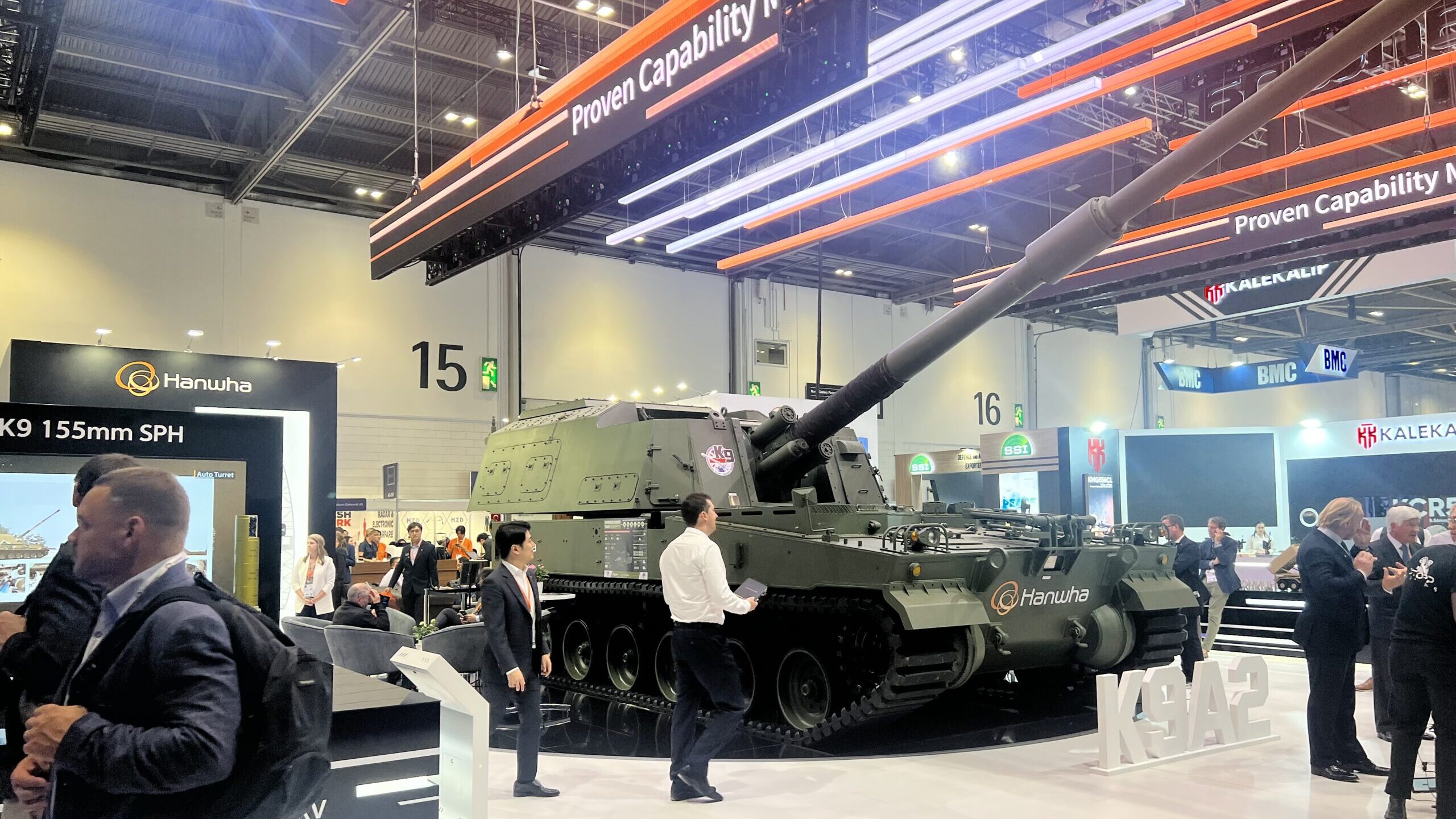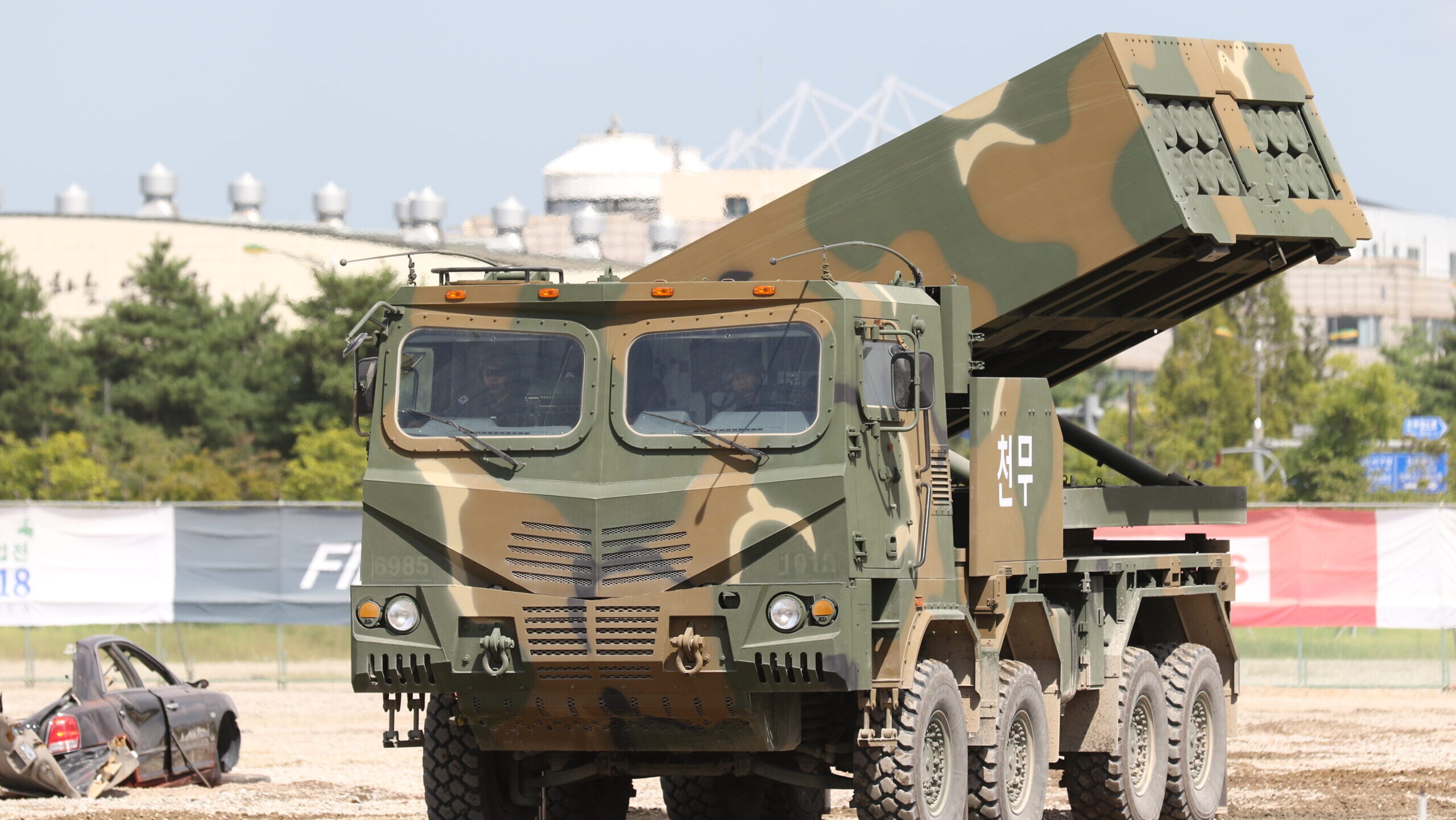
Korean defense contractor Hanwha made its presence known at the show with a few vehicles on display at DSEI 2023, including its new K9A2 self-propelled howitzer. (Lee Ferran / Breaking Defense)
SEOUL — Last year, South Korean President Yoon Suk Yeol stated publicly a goal of one day being among the world’s top four weapons suppliers, behind the US, Russia and France. It was an ambitious goal, to be sure, but one that doesn’t seem nearly as impossible as it would have even a few years ago, thanks to a series of major deals inked by Seoul and its domestic arms industries.
The Stockholm International Peace Research Institute listed South Korea as the world’s ninth largest arms exporter from 2018-22. It was one of only two Asian nations to appear among the top 25 exporters (the other being China in fourth place). What is perhaps more astounding is that, in this five-year period, South Korean arms sales exploded 74 percent compared to 2013-17.
“Since the late 2000s and early 2010s, the South Korean government began ambitious efforts to strengthen export-led characteristics in the country’s defense industry,” Kim Jae Yeop, Senior Researcher at the Sungkyun Institute for Global Strategy in Seoul, told Breaking Defense. “These efforts intended to not only boost substantial economic value for Korean defense industry, such as creating more employment or seeking profits, but also to enhance industry’s long-term competitiveness to survive fierce competition among numerous arms suppliers around the world.”
Those efforts seem to be paying off, as Kim described 2022 as a year of “unprecedented success for arms exports to foreign markets.” Last year, defense exports reached $17.3 billion, more than double the $7.25 billion achieved in 2021. And that number is likely to go up when 2023 is concluded, thanks to the sale of fighters to Malaysia, ground vehicles to Australia and a rumored air defense system sale to Saudi Arabia.
How did South Korea get here? Officials from government and industry in Seoul point to a few key factors, but one through line seems to come down to the ties between the government and its favored industrial partners.
Reasons for South Korean Success
First, start with production. The existence of hot production lines by the likes of Hanwha, Hyundai Rotem, LIG Nex1, Hyundai Heavy Industries, Kia Motors and Korea Aerospace Industries (KAI) — primarily to meet domestic demand, but easily diverted to meet export orders — is one reason why Seoul is scooping serious overseas defense contracts.
Hanwha Aersopace’s Plant 3 in Changwon, for example, is ramping up its ability to build K9 155mm self-propelled howitzers. The factory recently doubled annual production capacity to 160 K9s by establishing a second assembly line. That figure will climb to 240 K9s annually once a third production line opens in April 2024.
During a tour of his facility, Lee Kyounghun, senior vice president of the Changwon Plant 3 production department, told Breaking Defense that it takes just three weeks to build a K9. Furthermore, even whilst enhancing capacity at home, Hanwha Aerospace is simultaneously establishing K9 assembly lines in Australia, Egypt and Poland.
RELATED: American arm of Korea’s Hanwha has a 10-year plan to become a US land systems prime
Demonstrating the speed at which manufacturers can deliver, the first 10 K2 tanks and 24 K9s were unloaded onto Polish docks last December, just four months after contract signature. So far, Hanwha has delivered 48 K9A1s to Poland, and another batch of 18 left Changwon on Oct. 23. Similarly, the first FA-50 aircraft reached Poland within ten months of a contract being signed in September 2022.
Such alacrity is rare for American or European OEMs, but South Korea can deliver swiftly because of a symbiotic relationship between government and arms companies, where domestic deliveries can be rearranged to meet export orders. South Korean officials have, at least so far, been willing to postpone intake of their own weapons in order to encourage weapon sales abroad.
Tied into production is localization. South Korean companies have freedom to customize equipment to client needs, and also transfer technology and set up local production.
For instance, Egypt placed a KRW2 trillion ($1.6 billion) order on Feb. 1, 2022 for K9s and K10 ammunition resupply vehicles. Initial vehicles will be built in South Korea, but eventually the state-run Factory 200 outside Cairo will assemble K9s with 30 percent of content produced locally. There are side benefits for South Korea to localization, for it creates resiliency with a strategic production capacity and secondary supply chain outside its own borders.

A K239 Chunmoo multiple rocket launcher. Breaking Defense spotted examples destined for a Middle East customer at Hanwha Aerospace’s facility in Changwon.
(Gordon Arthur/Breaking Defense)
A third factor in growing export sales is quality and technology, which is once again driven by government working with industry.
Said Kim, “Surrounded by hostile and formidable military powers like North Korea, China and Japan, South Korea is required to maintain an indomitable defense posture. This has led to Seoul’s defense industry developing and manufacturing technically reliable weapons, and utilizing the country’s own world-class industrial bases like shipbuilding, electronics, automobiles, machinery, etc.”
Kim highlighted price competitiveness as another reason for South Korea’s attractiveness, particularly in comparison to generally pricier items from developed powers like the US and Europe. “As a result, more countries — especially emerging small and medium powers – pay attention to Korea as a supplier for weapons of both quality and affordability.”
Why Exports Have Increased Recently
Still, the factors listed above have been true for some time. Asked why 2022 was such a banner year, several defense employees joked that their biggest customers are Kim Jong-un and Vladimir Putin, whose bellicosity towards neighbors has driven global weapon sales in the last 18 months.
This underscores another cause of Seoul’s success, its willingness to support those countries intimidated by oppressive states. Having faced Pyongyang’s belligerence for the past 70 years, South Korea empathizes with democracies like Poland who face dangerous threats along their frontiers.
RELATED: Biden says Camp David trilateral will usher in ‘new era’ between US-ROK-Japan
“It is noteworthy that major recipients of South Korean weapon systems mostly include Southeast Asian countries, India, Australia and North and East European countries facing security threats from aggressive, revisionist great powers like China and Russia,” said Kim. “In other words, arms exports by South Korea are providing substantial support for the defensive efforts of these countries.”
Despite important contracts in Asia, Europe and the Middle East, the real prize for South Korean companies is the Five Eyes market. This makes Hanwha’s recent wins in Australia all the more significant.

This is a Hyundai Rotem K2 main battle tank of the ROK Army. Poland emerged as the tank’s first export customer following a 2022 contract. (Gordon Arthur/Breaking Defense)
The sale of 129 AS21 Redback infantry fighting vehicles, plus 30 AS9 Huntsman howitzers and 15 AS10 ammunition resupply vehicles, gives the company a real foot in the Five Eyes door, one upon which it wishes to capitalize. Those will be assembled with significant Australian industrial content at a new plant near Geelong, Victoria. This production facility is being built in phases, so it could manufacture equipment for other export markets in the future too.
The goal above all, however, remains South Korea breaking into the lucrative American market. A small step has been achieved by selling 155mm artillery rounds to the U.S. While Seoul refuses to deliver lethal aid directly to Ukraine, it is willing to replenish American ammunition stocks for missing rounds that have been shipped to Kyiv. In April, the two governments reportedly agreed to the supply of 500,000 artillery rounds, on top of 100,000 shells delivered in 2022.
The trajectory of South Korea’s defense industry is trending upwards; it is difficult to estimate just how high it will reach, as this will be determined by conflicts and tensions around the globe.






















